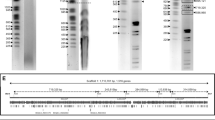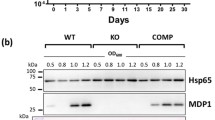Summary
On the basis of genetic, physiological and biochemical data an attempt is made to explain the syndrome of senescence in Podospora anserina. A covalently closed circular DNA (ccc DNA) found only in aging mycelia is considered as the causative agent. It is assumed that during the juvenile phase this species of DNA is an integrated part of the mitochondrial genome. During the presenescent phase it becomes independent from the chondriome and begins to replicate within the mitochondrion. This amplification leads progressively to the senescent phase, where the mitochondria desintegrate and ccc DNA molecules are liberated which are able to propagate autonomously in the cytoplasm and transmit senescence through infection involving cytoplasmic exchange.
Similar content being viewed by others
References
Belcour, L., Begel, O.: Lethal mitochondrial genotypes in Podospora anserina: a model for senescence. Mol. Gen. Genet. 163, 113–123 (1978)
Bonanchang, D.U., Scavizzi, M.R., Chabbert, Y.A.: Elimination by ethidiumbromide of antibiotic resistance in enterobacteria and staphylococci. J. Gen. Microbiol. 54, 417–524 (1969)
Cummings, D.J., Belcour, L., Grandchamp, C.: Mitochondrial DNA from Podospora anserina. II. Properties of mutant DNA and multimeric circular DNA from senescent cultures. Mol. Gen. Genet. 171, 239–250 (1979)
Esser, K.: Podospora anserina. In: Handbook of genetics, Vol. I (R.C. King, ed.), pp. 531–551. New York: Plenum Press 1974
Esser, K., Keller, W.: Genes inhibiting senescence in the ascomycete Podospora anserina. Mol. Gen. Genet. 144, 107–110 (1976)
Esser, K., Tudzynski, P.: The prevention of senescence in the ascomycete Podospora anserina by the antibiotic Tiamulin. Nature 265, 454–456 (1977)
Hayflick, C.: Current theories of biological aging. Fed. Proc. 34, 9–13 (1975)
Marcou, D.: Sur la longévité des souches de Podospora anserina cultivées à divers températures. C.R. Acad. Sci. (Paris) 239, 895–897 (1954a)
Marcou, D.: Sur le rajeunissement par le froid des souches de Podospora anserina. C.R. Acad. Sci. (Paris) 239, 1153–1155 (1954b)
Marcou, D.: Rajeunissement et arrêt de croissance chez Podospora anserina. C.R. Acad. Sci. (Paris) 244, 661–663 (1957)
Marcou, D.: Sur le déterminisme de la sénescence observée chez l'ascomycète Podospora anserina. Proc. X. Intern. Congr. Genet. Montreal 1958, Vol II, p. 179
Marcou, D.: Notion de longévité et nature cytoplasmique du déterminant de la sénescence chez quelques champignons. Ann. Sci. Natur. Bot. Sér. 12, 2, 653–764 (1961)
Munkres, K.D., Rana, R.S.: Antioxidants prolong life span and inhibit the senescence-dependent accumulation of fluorescent pigment (lipofuscin) in clones of Podospora anserina. Mech. Ageing Dev. 7, 407–415 (1978)
Raynal, A.: Evidence for a common cytoplasmic determinant of longevity and senescence in the ascomycete Podospora anserina. Mol. Gen. Genet. 175, 281–292 (1979)
Rizet, G.: Sur l'impossibilité d'obtenir la multiplication végétative ininterrompue et illimitée de l'ascomycète Podospora anserina. C.R. Acad. Sci. (Paris) 237, 838–840 (1953a)
Rizet, G.: Sur la longévité des souches de Podospora anserina. C.R. Acad. Sci. (Paris) 237, 1106–1109 (1953b)
Rizet, G.: Les modifications qui conduisent à la sénescence chez Podospora anserina sont-elles de nature cytoplasmique. C.R. Acad. Sci. (Paris) 244, 663–665 (1957)
Rizet, G., Marcou, D.: Longévité et senescence chez l'ascomycète Podospora anserina. C.R. 8. Intern. Congr. Botany, Paris 1954, Sect. 10, pp. 121–128
Smith, J.R., Rubenstein, I.: The development of senescence in Pdospora anserina. J. Gen. Microbiol. 76, 283–296 (1973a)
Smith, J.R., Rubenstein, I.: Cytoplasmic inheritance of the timing of senescence in Podospora anserina. J. Gen. Microbiol. 76, 297–304 (1973b)
Stahl, U., Lemke, P., Tudzynski, P., Kück U., Esser, K.: Evidence for plasmid like DNA in a filamentous fungus, the ascomycete Podospora anserina. Mol. Gen. Genet. 162, 341–343 (1978)
Strehler, B.L.: Time, cells and aging. New York: Academic Press 1977
Tudzynski, P., Esser, K.: Inhibitors of mitochondrial function prevent senescence in the ascomycete Podospora anserina. Mol. Gen. Genet. 153, 111–113 (1977)
Tudzynski, P. Esser, K.: Chromosomal and extrachromosomal control of senescence in the ascomycete Podospora anserina. Mol. Gen. Genet. 173, 71–84 (1979)
Author information
Authors and Affiliations
Additional information
Communicated by F. Kaudewitz
Rights and permissions
About this article
Cite this article
Esser, K., Tudzynski, P., Stahl, U. et al. A model to explain senescence in the filamentous fungus Podospora anserina by the action of plasmid like DNA. Molec. Gen. Genet. 178, 213–216 (1980). https://doi.org/10.1007/BF00267231
Received:
Issue Date:
DOI: https://doi.org/10.1007/BF00267231




